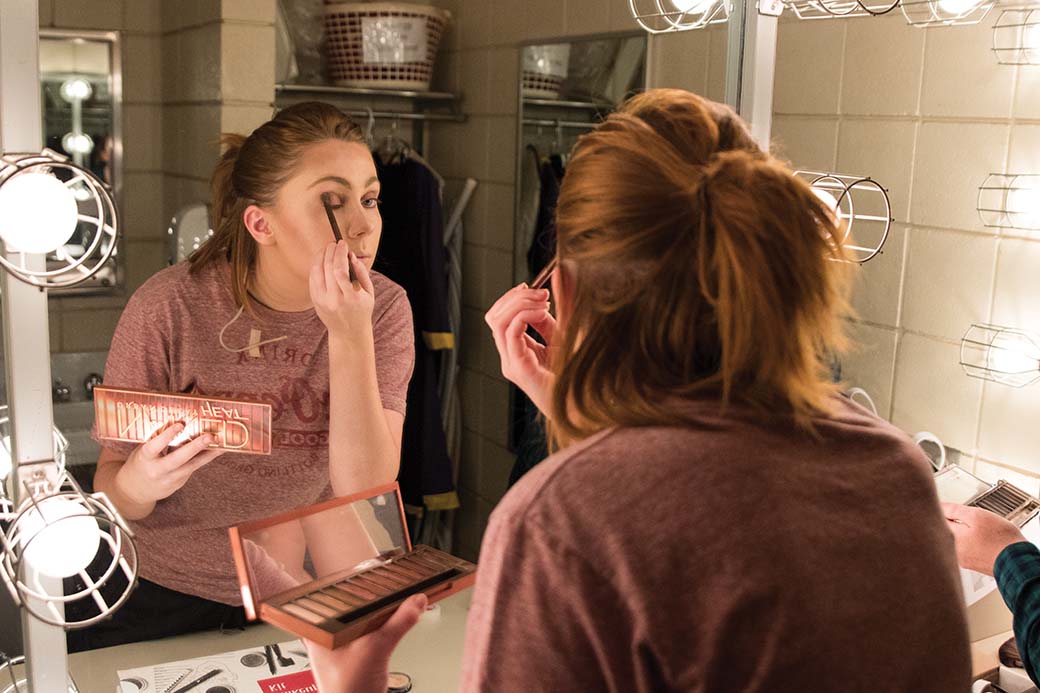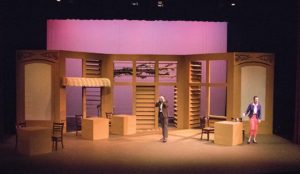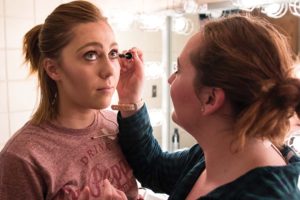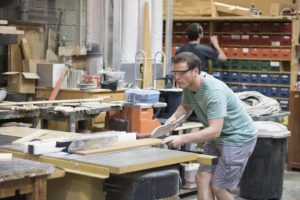
Behind the scenes of ‘Rhinoceros’: Putting a production together
Before a production is ready for an audience, its cast and crew puts in an immense amount of time and effort to perfect the show.
Work for “Rhinoceros” began last semester. The design process for a production this size can take eight to 12 weeks, said technical director Scott Mollman.
The crew has multiple production meetings where they discuss the director’s vision, as it’s their job to bring that vision to life, he said.

Kiah Schaeffer, a junior theater major with an emphasis in costuming, has worked on the wardrobe crew for many productions, but this is her first show as costume designer.
“The director sets parameters, then I take those ideas and get to be creative,” Schaeffer said. “We have production meetings to check up and make sure we are headed in the right direction.”
Each theater student in the costume department is the designer for one show. Professors assign shows to each student based on their interests and skill sets.
“At the end of last semester, one of my professors approached me and asked if I would like to design the costumes for ‘Rhinoceros,'” Schaeffer said. “The costumes for this show are more modern and that is typically what I like to design.”

Certain actors are only on stage for one scene, but a few actor’s costumes transition into rhinos throughout the course of the play. Although the costumes for this show are relatively simple, they require a lot of time because they’re handmade, she said.
“The actors do not transform into literal rhinos, more of a rhino concept, so bringing that idea to life was a little challenging,” Schaeffer said. “All 26 costumes must be the same color scheme, so instead of using costumes from previous shows we have to make them all from scratch.”
Schaeffer is also in charge of designing the production’s makeup sketches. “Rhinoceros” will include basic stage makeup and makeup transitions during each show when actors transform into rhinos off-stage.
Since the makeup for this show is rather simple, actors will apply their own.
The set
In addition to makeup and costuming, students must also design and build the production sets. Certain theater classes have a lab that requires students to work in the shop anywhere from two to 10 hours each week. Graduate students and practicums also have a set number of shop hours.
Ryan Stewart, a first-year graduate student, is one of the carpenters for “Rhinoceros.” His role includes building sets and teaching students how to work the various tools in the shop. He said he’s put in 20 hours a week working on this production since the design process began.

“The hardest part for me personally as a graduate student, I feel like leadership has been thrust upon me,” Stewart said. “Getting used to the responsibility of being a student leader, coming from undergrad having younger students looking up to me for guidance has been hard getting used to.”
Stewart said he’s enjoying his role in the theater department.
“My favorite part of technical crew is getting to be part of the realization of a dream,” he said. “The designers dream it up off the blueprints and it’s quite a labor and work, but sitting out in the audience and seeing what you built and how all the elements of the theater come together is an amazing feeling.”
Mollman has worked on more than 300 plays in his professional career, and has been the technical director at USD for 14 years. As technical director, he’s in charge of work safety, building sets and figuring out how to budget for the show.
“The set for this show is smaller, but there is a lot of moving parts and engineering work that takes a long time to work on,” Mollman said.
As the show grows closer, the crew has to do even more work to prepare for the production.
“Rhinoceros” will play at Knutson Theatre in the Warren M. Lee Center for Fine Arts Sept. 28 through Oct. 1 and from Oct. 4 to Oct. 8.

